Bringing a Authentic Asian Feel to Your Dream Kitchen: Enjoying the Beauty of Diversity
The kitchen is often considered the heart of the home, a place where meals are prepared and memories are made. In recent years, Asian style kitchen design has gained popularity for its unique blend of functionality and aesthetics. Asian kitchens are known for their clean lines, natural materials, and minimalist approach to design. In this article, we will explore the key elements of Asian style kitchen design and provide tips on how to incorporate this style into your own home.
Key Elements of Asian Style Kitchen Design
1. Natural Materials: One of the hallmarks of Asian style kitchen design is the use of natural materials such as wood, stone, and bamboo. These materials add warmth and texture to the space, creating a welcoming and serene atmosphere.
2. Clean Lines: Asian kitchens are characterized by clean lines and simple forms. Cabinets, countertops, and appliances are often sleek and minimalistic, with an emphasis on functionality rather than ornamentation.
3. Neutral Colors: Asian style kitchens typically feature a neutral color palette, with shades of white, beige, and grey dominating the space. These colors create a sense of calm and tranquility, making the kitchen a peaceful retreat from the hustle and bustle of daily life.
4. Zen-Inspired Design: Zen principles, such as simplicity, balance, and harmony, are often incorporated into Asian style kitchen design. This can be seen in the use of natural materials, minimalist furniture, and uncluttered spaces.
5. Natural Light: Asian kitchens often feature large windows or skylights to bring in natural light. This not only brightens the space but also creates a connection to the outdoors, enhancing the sense of tranquility and serenity.
Tips for Incorporating Asian Style Kitchen Design
1. Start with the Basics: Begin by selecting natural materials such as wood or stone for your countertops, cabinets, and flooring. Opt for simple, clean lines and avoid ornate details or excessive decoration.
2. Create a Focal Point: Consider adding a statement piece to your kitchen, such as a beautiful pendant light or a striking piece of artwork. This will draw the eye and create visual interest in the space.
3. Embrace Minimalism: Keep your kitchen clutter-free by only displaying essential items on countertops and shelves. Use hidden storage solutions to maintain a clean and organized look.
4. Add Greenery: Incorporate plants or fresh flowers into your kitchen to bring a touch of nature indoors. Not only will this add color and texture to the space, but it will also improve air quality and create a sense of well-being.
5. Pay Attention to Lighting: Lighting plays a crucial role in Asian style kitchen design. Opt for soft, ambient lighting that creates a warm and inviting atmosphere. Consider adding under-cabinet lighting or pendant lights to enhance the overall ambiance.
Conclusion
Asian style kitchen design offers a unique blend of functionality and aesthetics, creating a space that is both beautiful and practical. By incorporating natural materials, clean lines, and minimalist design principles, you can create a kitchen that is both stylish and serene. Whether you prefer a traditional Japanese-inspired design or a modern take on Asian aesthetics, there are endless possibilities for creating an Asian style kitchen that suits your taste and lifestyle.

So stunning and beautiful
Dreams kitchens